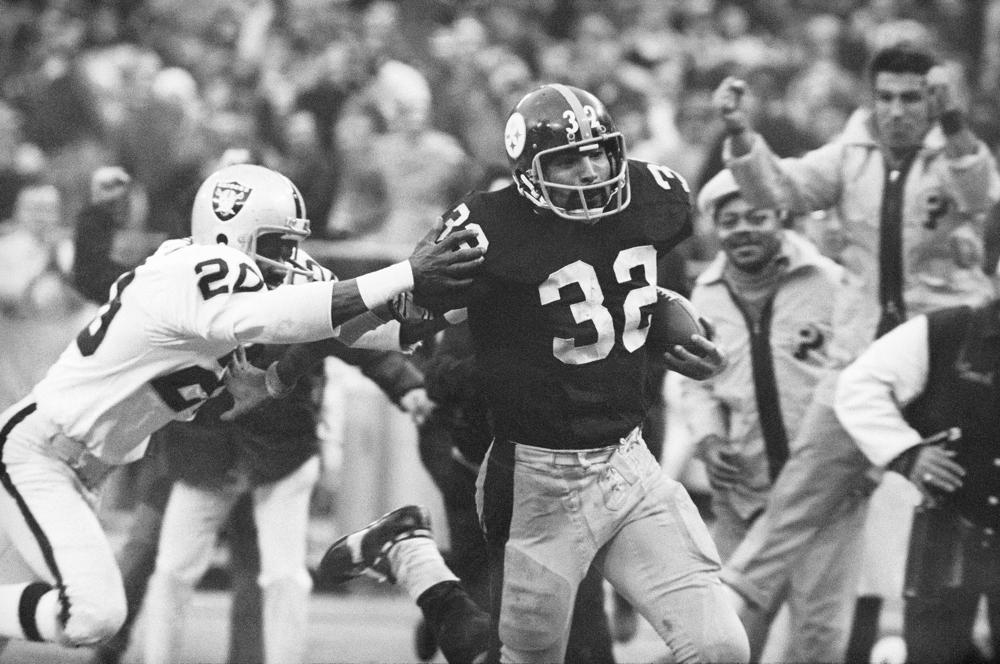And it all began with a play that shifted the fortunes of a franchise and, in some ways, a region.
“It’s hard to believe it’s been 50 years, that’s a long time,” Harris said in September when the team announced it would retire his number. “And to have it so alive, you know, is still thrilling and exciting. It really says a lot. It means a lot.”
Harris, a 6-foot-2, 230-pound workhorse from Penn State, found himself in the center of it all. He churned for a then-record 158 yards rushing and a touchdown in Pittsburgh’s 16-6 victory over Minnesota in Super Bowl IX on his way to winning the game’s Most Valuable Player award. He scored at least once in three of the four Super Bowls he played in, and his 354 career yards rushing on the NFL’s biggest stage remains a record nearly four decades after his retirement.
“One of the kindest, gentlest men I have ever known,” Hall of Famer Tony Dungy, a teammate of Harris’ in Pittsburgh in the late 1970s, posted on Twitter. “He was a great person & great teammate. Hall of Fame player but so much more than that. A tremendous role model for me!”
Born in Fort Dix, New Jersey, on March 7, 1950, Harris played collegiately at Penn State, where his primary job was to open holes for backfield mate Lydell Mitchell. The Steelers, in the final stages of a rebuild led by Hall of Fame coach Chuck Noll, saw enough in Harris to make him the 13th overall pick in the 1972 draft.
“When (Noll) drafted Franco Harris, he gave the offense heart, he gave it discipline, he gave it desire, he gave it the ability to win a championship in Pittsburgh,” Hall of Fame wide receiver Lynn Swann said of his frequent roommate on team road trips.
Harris’ impact was immediate. He won the NFL’s Rookie of the Year award in 1972 after rushing for a then-team-rookie record 1,055 yards and 10 touchdowns as the Steelers reached the postseason for just the second time.
The city’s large Italian-American population embraced Harris immediately, led by two local businessmen who founded what became known as “Franco’s Italian Army,” a nod to Harris’ roots as the son of an African-American father and an Italian mother.
Though the “Immaculate Reception” made Harris a star, he typically preferred to let his play and not his mouth do the talking. On a team that featured big personalities in Bradshaw, defensive tackle Joe Greene and linebacker Jack Lambert among others, the intensely quiet Harris spent 12 seasons as the engine that helped Pittsburgh’s offense go.
Eight times he topped 1,000 yards rushing in a season, including five times while playing a 14-game schedule. He piled up an additional 1,556 yards rushing and 16 rushing touchdowns in the playoffs, both second all-time behind Emmitt Smith.
Despite his gaudy numbers, Harris stressed that he was just one cog in an extraordinary machine that redefined greatness.
“You see, during that era, each player brought their own little piece with them to make that wonderful decade happen,” Harris said during his Hall of Fame speech in 1990. “Each player had their strengths and weaknesses, each their own thinking, each their own method, just each, each had their own. But then it was amazing, it all came together, and it stayed together to forge the greatest team of all times.”
Harris also made it a habit to stick up for his teammates. When Bradshaw took what Harris felt was an illegal late hit from Dallas linebacker Thomas “Hollywood” Henderson in the second half of their meeting in the Super Bowl following the 1978 season, Harris basically demanded that Bradshaw give him the ball on the next play. All Harris did was sprint up the middle 22 yards — right by Henderson — for a touchdown that gave the Steelers an 11-point lead they would not relinquish on their way to their third championship in six years.
Despite all of his success, his time in Pittsburgh ended acrimoniously when the Steelers cut him after he held out during training camp before the 1984 season. Noll, who leaned on Harris so heavily for so long, famously answered “Franco who?” when asked about Harris’ absence from the team’s camp.
Harris signed with Seattle, running for just 170 yards in eight games before being released in midseason. He retired as the NFL’s third all-time leading rusher behind Walter Payton and Jim Brown.
“I don’t even think about that (anymore),” Harris said in 2006. “I’m still black and gold.”
Harris remained in Pittsburgh following his retirement, opening a bakery and becoming heavily involved in several charities, including serving as the chairman of “Pittsburgh Promise,” which provides college scholarship opportunities for Pittsburgh Public School students.
“I think everybody knows Franco, not just for the work he did on the field but off the field,” Steelers defensive lineman Cam Heyward said Wednesday. “I think he was there making change, being involved in everything he could.”
Harris is survived by his wife, Dana Dokmanovich, and son Dok.

